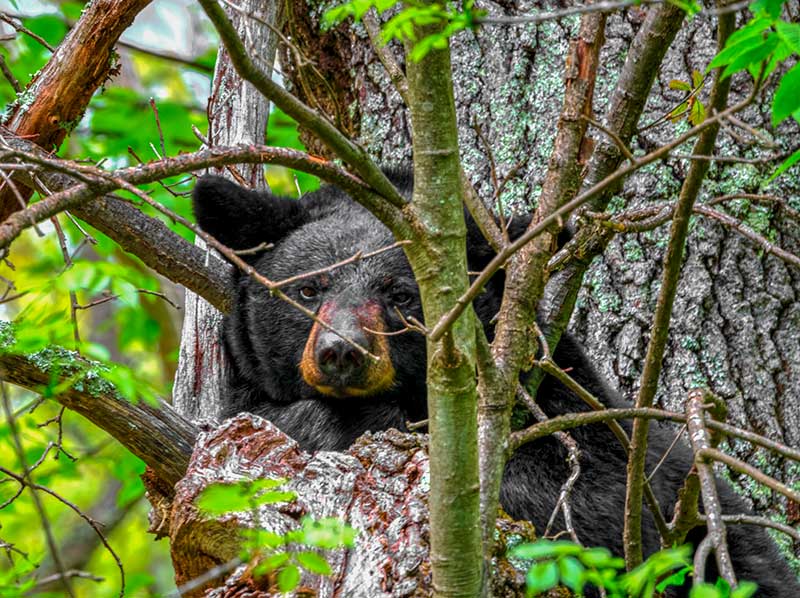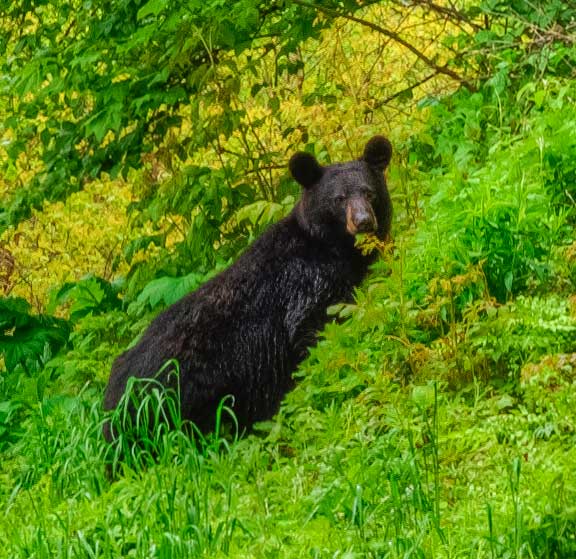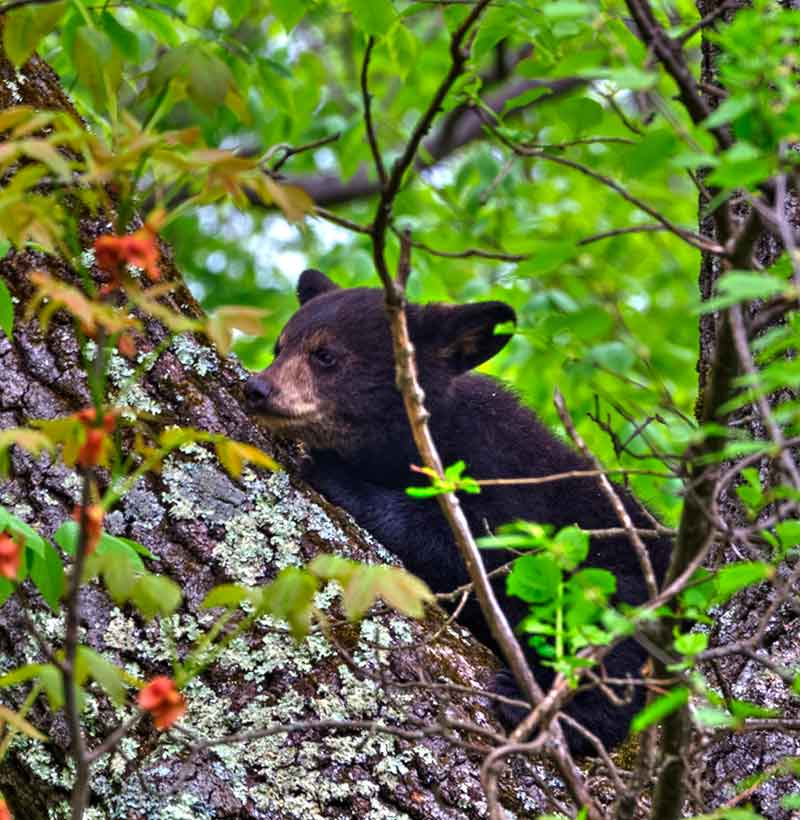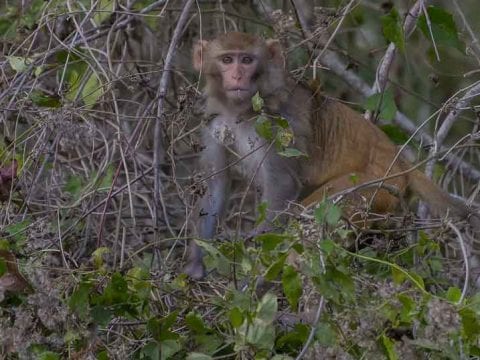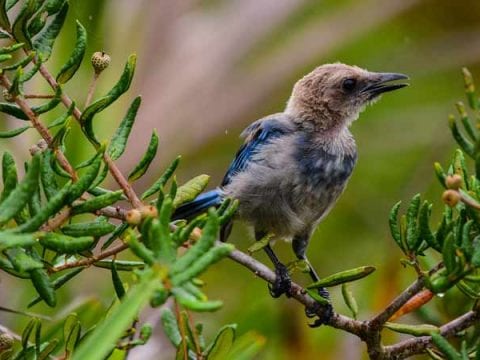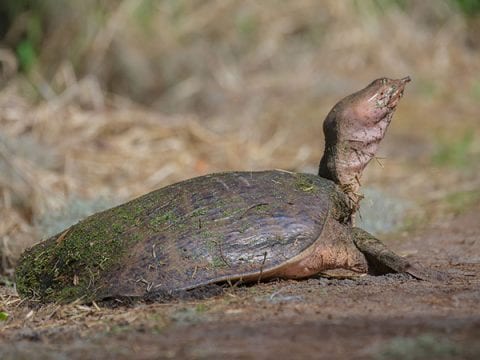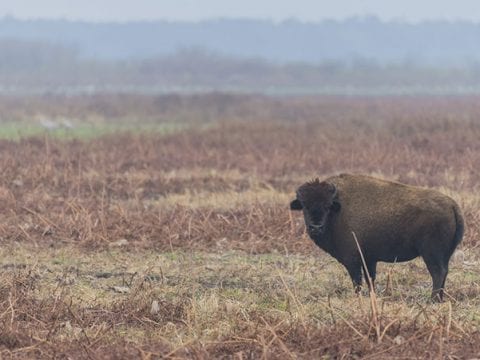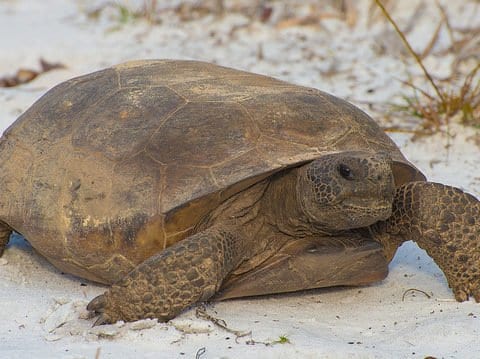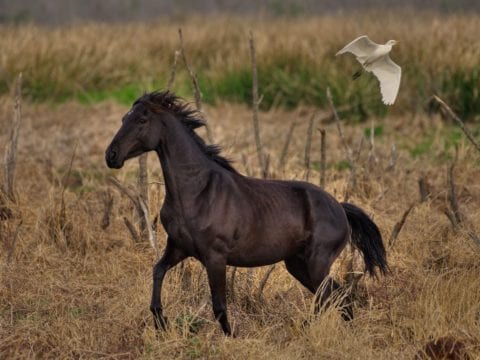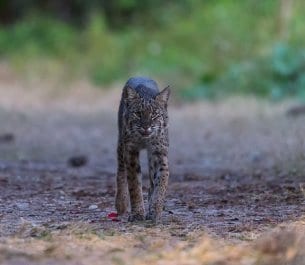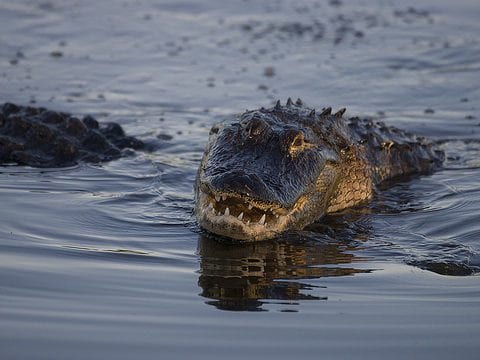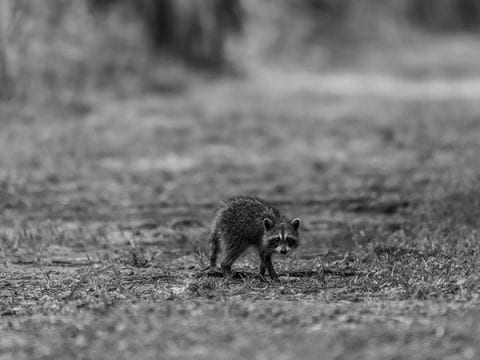Table of Contents
My Experience With Black Bear In Shenandoah National Park
I’m in Shenandoah National Park every week to hike the trails and film wildlife I run into. I see black bear quite often along Skyline Drive as well as the hiking trails I’m on. They are very hard to spot as they blend right into the landscape. If you keep an eye out, you’ll see one for sure especially during certain times of the year (coming out of hibernation & feeding to get ready for hibernation).
I wanted to publish an article to go over my experiences and offer facts on bear so that when you visit, you’ll be educated and prepared when you see one too. I’ve never been charged and I always keep my distance. I would say that hiking with bear in the park is safe but you should always have a plan. Keep your eyes and ears open and respect them when you run into them.
Video Of Black Bear From My Hike
Black Bear Facts
- Scientific name: Ursus americanus
- Medium-size bear, though black bears are the smallest and most popular bear in the United States
- Most common bear species
- They are omnivores, their diets vary based on the season and location they are currently in
- They use forest areas for cover to find food and do not often leave to obtain food. However, if they become hungry and food is unavailable, near-by parks where humans are picnicking could attract a bear (Read below to find out what to do in case you see a bear)
- Despite popular belief, black bears are not closely related to brown bears or polar bears. Genetic studies have shown that the species split more than 5 million years ago
- A smaller primitive bear known as Ursus abstrusus is the oldest known North American fossil of the genus Ursus which dates back to more than 5 million years ago. This suggests that this primitive bear could be a direct ancestor for the American black bear
- The oldest American black bear fossils were found in Port Kennedy, Pennsylvania
- Bigger in the past, black bears have shrunken through the years
- Baribal means black bear in French, Italian, German, Russian, Czech and Polish languages
- The overall population of black bears in the United States is estimated between 333,000 and 465,000
- In Mexico, the black bear is classified as endangered
- They make up to 20 different sounds: All combinations of growls, snorts, bellows, mumbles, pants, squeaks, woofs and roars
- Black bears are not usually preyed upon because of their size but cub predators include wolves, cougars, brown bears, bobcats and coyotes
- Black bears have great close-up vision but it really drops off – They can see at night just fine
- They have a better sense of smell than a dog
- They usually mark trees up by using their teeth and claws to communicate with other bears. This is a common behavior between bears of all species
- Average lifespan for a black bear in the wild is 18 years, though some have lived up to 23 years
- In captivity, black bears can live up to 44 years
- On average, the survival rate for black bears who survive past their first year is 60 percent
- Black bears, all bears in fact, are bowlegged which gives them better grip and balance
- Black bears are very popular in culture, in fact, the idea of Winnie the Pooh was derived from a black bear cub name Winnipeg. In other popular black bear history, teddy bear creator, Morris Michtom was inspired to create the cuddly stuffed animal after coming across a cartoon of Theodore Roosevelt refusing to shoot a black bear cub that had been tied to a tree. Popular Smokey Bear, who is the mascot for the United States Forest Service was inspired by a black bear cub who was caught in the Captain Gap fire in 1950.
Identification
Black bears have a broad skull, a narrow muzzle and a large jaw. Female black bears have a pointier, slender face then a male. For both genders, their claws are generally black or grayish brown, they are round, short and thickest at the base. They are the same for their hind legs as they are on their front. However, their front claws appear to be more curved. Their paws are fairly large but are actually smaller than that of a brown bear or polar bear. The foot soles of a black bear are wrinkled and leathery and black/brown in color. Their tails are fairly short and their ears are round and very small in size.
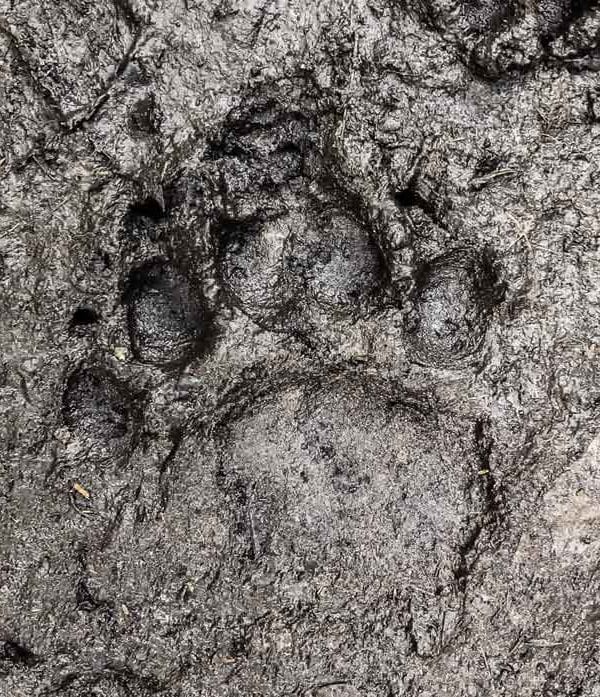
A black bear print in mud found at Black Bear Wilderness Preserve in Sanford, FL
The black bears pelage (fur) is very soft, it comes in two layers, the underfur, which is dense and the guard hairs, which are thick and coarse. While they are named black bears, they actually have a color variation in their pelage that ranges from jet black to chocolate brown, light brown, cinnamon, blond and white. Some black bears develop a white crescent moon shaped mark on their chest but only about 25 percent of them have it.
Size
Bears are very large in weight but their weight also depends on their health, sex, age and what season it is. For example, in autumn bears can weigh 30 percent more than they weigh during the spring.
Shoulder Height
- 28-41 inches
Paws
- 5.4-8.9 inches
Tail Length
- 4.8 inches
Adult Male Weight
- 126-551 lbs.
Adult Female Weight
- 90-375 lbs.
On average however, males weigh about 190 lbs. and females weigh about 128 lbs. Head-to-body Length is 47-79 inches
The biggest wild American black bear that was ever recorded lived in New Brunswick before he was shot in 1972. He weighed 902 lbs. and measured 7.9 ft. long.
In Virginia, the length of an adult bear skull averaged between 10.5 to 12.5 inches. The greatest skull length found however, was 9.3 to 13.8 inches.
Behavior
Black bears are very dexterous and are good at opening door latches and screw-top jars. Their eyesight is very good and they have been known to pick up very quickly when distinguishing different shapes such as squares, circles and triangles. They are also physically strong and can overturn flat-shaped rocks weighing anywhere from 310 to 325 pounds. They move in a rhythmic way and can run up to 30 mph.
Black bears are territorial in nature and males will dominate over fruit-feeding spots. They do this by marking up the area (such as the bark of a tree) with their claws or rubbing their bodies over the area. They are excellent swimmers and very much like to swim for pleasure as much as searching for food, particularly, fish. They also like to climb trees where they will search for food, hibernate or even escape an enemy. Black bears are active during the day and night, however, they usually start foraging during the night.
Black Bear Trailers & Traps
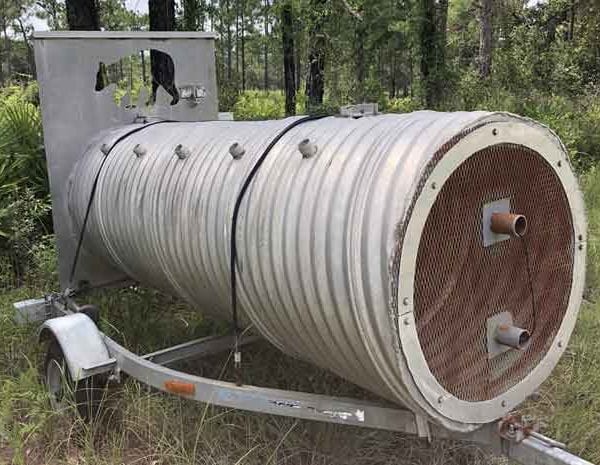
Black bear trap and transport as seen in Rock Springs Run State Park (Florida).
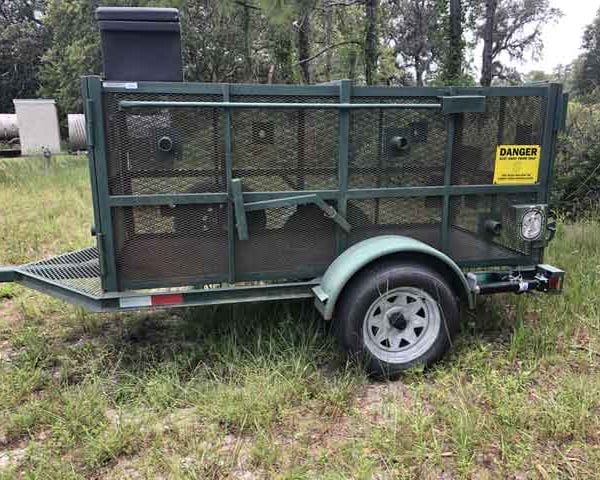
Black bear trap in Rock Springs Run State Park (Florida).
Habitat
Black bears are comfortable in settings of large forestry terrain and that is where they like to stay. However, sometimes it becomes very hard to find food in their area and they will travel outside their comfort food to find food. From time to time, humans will find bears in their backyard because they are looking for food.
They are usually found in elevation of 1,300-9,800 feet within the United States. They enjoy areas with hardwoods that create a forest canopy because they enjoy hiding spots such as beech, maple or birch trees.
Hibernation
At one time, black bears were not considered to be deep hibernators but recent studies have proved that that to be a different case. Studies show that black bears are actually highly efficient hibernators due to their ability to remain dormant for months without drinking, eating, defecating or urinating.
During this time, male black bears reside in hollowed-out trees, in caves or under large rocks. Females however, have shown to be slightly pickier when it comes to where they hibernate. Either way, a black bear will usually dig out an area to use as their hibernation spot though some prefer a nature-made area.
For their hibernation period, black bears enter their den in October and November. Before they go into hibernation, they can store up to 30 lbs. of body fat that is needed through the average seven-month hibernation period. Hibernation period can be between three-to-eight months but the amount of time that they hibernate depends on the regional climate.
While hibernating, their heart rate drops from 40-50 beats per minute to about 8 beats per minute. They lose about half their muscular strength and they appear to retain all their excretory waste. A special hormone, called leptin releases into the black bears system which allows their appetite to become suppressed.
After the hibernation period has ended in spring, they awake to roam around to allow time for their metabolism to grow accustom to movement. They begin to forage for food at low climates, as their bodies are still very weak from atrophy.
Diet
As per a black bear’s diet, vegetation consists of about 85 percent of it. When emerging from their hibernation period, they will usually eat on animals that have been killed by the cold and carrion. However, as it grows warmer outside, they will seek out plant life such as forbs, wetland plants and grasses. During the summer, black bears start to turn toward fruits like berries. They have fully healed from the hibernation period which means it’s time for them to start preparing for the next hibernation period by stocking up on food. Eating is a full time commitment for black bears during the summer months. Autumn continues to be a stocking period for black bears as they seek out whitebark pine nuts, huckleberries, buffalo berries, hazelnuts and oak acorns. Just like Pooh Bear, black bears love honey and they will gnaw through trees to get to a hive that has been deeply hidden away in the trunk. They will scrape away at the honeycomb despite being stung by bees. They will also seek out small animals such as insects: bees, ants and yellow jackets.
Fish is a great option for black bears to eat and it is very common to see them fishing for salmon through the night. They will also fish for catfish, trout and black suckers.
Reproduction
Black bears are re-productively compatible with many other different types of bear species which leads to the production of hybrid offspring. The sow (female black bear) will typically produce her first litter between the age of 3-5 years of age.
Breeding period generally occurs during June-July, though it can last through August. During which, both sexes are promiscuous. Males will try to mate with many different females but some large dominate males will become violent if any other males approach his mate.
After copulating, some females will become short tempered. Their eggs are being fertilized, once this happens they will not implant into the womb until November. The gestation period will last 235 days and a litter of cubs will be born sometime between late January and early February. The litter size ranges between 1-6 cubs but on average a sow will have 2-3.
Newborn Cub Description
Weight
- 0.62-0.99 lbs., at 6 months, they weigh 40-60 lbs.
Length
- 8.1 in.
Their fur is very fine and gray when they are born. Their hind legs are very underdeveloped and they are open up their eyes 28-40 days after birth. The cub will start to walk five weeks after birth and they are dependent upon their mother’s milk up to 30 weeks after birth. At 3 years old, they reach sexual maturity and at 5 years old, they are considered fully grown.
Black Bear Attacks
Typically, black bears try to avoid confrontations with humans. They prefer to stay unseen and covered by the forest. However, if they feel threatened or, are surprised by a hiker coming around a corner, there’s always a chance they could attack or bluff charge you and it’s important to know what to do. I hike a lot in Shenandoah and see bear all the time and I’ve never had an issue. However, it’s always best to be educated and prepared. From what I understand, there has never been a black bear attack in Shenandoah National Park on a human.
On August 3, 2016, a dog walker was walking along the Snead Farm Fire Road (Dickey Ridge Visitors Center) when a mother bear and her 2 cubs approached the dog walker. The dog walker attempted to flee and the mother bear chased and killed one of the trailing leashed dogs.
Reasons There Might Be An Attack
- A mother protecting her cub – If you see a mother and cub, stay away
- During mating season – If you see 2 adults together, stay away
- Being too close to their food source – Cherry trees, apple trees, raspberry plants, etc.
Things To Do Before Going Into Bear Country
- Use bear bells
- Bring bear spray
The most important thing one can do when it comes to an attack by an animal is to educate oneself. For instance, bears typically do not attack humans, even when confronted by them. Instead, they will begin swatting the ground, start to mock charge at the human and even make blowing sounds with their mouth. These are all warning signs from the black bear to get away.
- Never try to feed a bear from your own lawn. If a bear comes in your yard regularly and you put food out for them to eat, the bear will grow accustom to eating human food. They will start to find attraction to human food over their own, leading them further into the city to find it. Some bears are attracted to backcountry garbage cans because of the smell of food coming from them.
- If you are hiking and see a black bear cub, do not approach it because the mama bear is not far behind. Some cubs will retreat up a tree if they feel threatened and a mama bear will attack if her cubs are in danger. It’s important to stay away from the cubs.
- Stay away from kill sites because black bears will defend them. These can be defined by large accumulations of ravens and other animals/birds scavenging.
- Make noise if you see a bear. This will alert them that you are present and they should simply move away. You should do the same.
- If you plan to travel to the open country, take your binoculars with you. You can scan the area you are hiking before you even start hiking. While hiking, make sure you make a lot of noise to let the animals know that you are there (this usually scares them away). Bear bells work well. I know park rangers that use them.
- If you are hiking along and spot a bear but the bear has not spotted you, do not draw attention to yourself. Just back away very slowly. If you have to travel down the same path as the bear, back away and give the bear time to travel it themselves first.
- If the bear has spotted you, it’s important not to show panic. That will make the bear feel as though it is threatened. Instead, speak calmly to the bear and make them aware that you are human. Bears will often give you the ground once they identify you as a human. Waving your arms slowly may help the bear identify you as a human.
- If you are talking calmly and waving your arms and the bear is showing signs of aggression, do not run. In this case, hopefully there is enough room between you and the bear, but do not run from the bear because you can’t outrun him/her. Instead, retreat very slowly to put more space between yourself and the bear. Never turn your back on one. Talk very calmly to the bear but do not make direct eye contact. Keep your backpack on for protection.
- Bring pepper spray designed for bear use. Each type has different instructions. Know how to use this device before going out into bear country. I always have a bottle of Counter Assault Bear Deterrent Spray on my waistband. Don’t keep it in your backpack, make sure you can access it quickly.
- If you get attacked by the bear and do not have pepper spray, you have to fight with whatever you have around you. Since black bears are more timid than grizzly bears, they may scare off if you start fighting back.
- Once the bear has retreated from the attack, stay patient. Remain still and look around to make sure the bear has fully retreated and then get to assistance quickly

